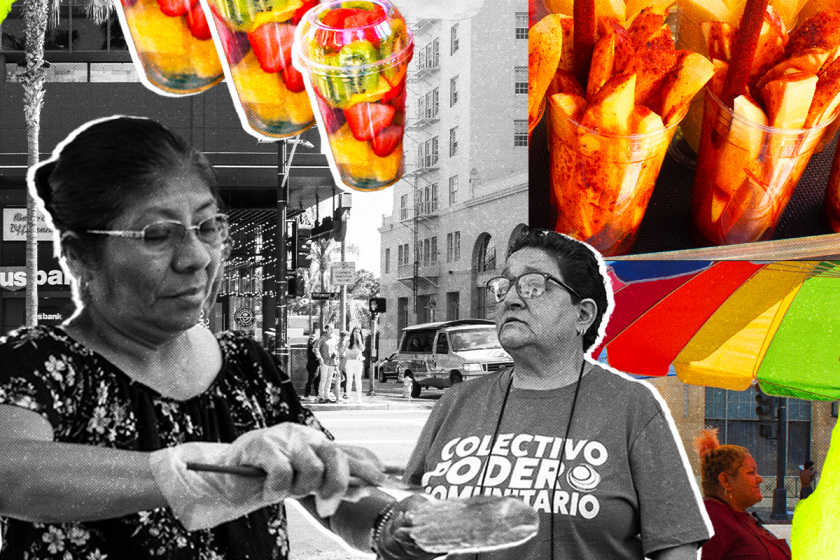
- Share via
Latino wealth has grown annually for the last 20 years, and data show that second-generation Latinos are faring better than their parents when it comes to their net worth.
But, amid these strides, Latinos still significantly lag behind white households when it comes to wealth accumulation.
And, it’s important to note, not all Latino wealth is equal.
At the height of the pandemic, most businesses were forced to alter operations, but for street vendors, who are subjected to zoning permits and rising food costs, things became even more unstable.
A new Brookings Metro report looks at the underlying causes of the wealth gap between Latino and white families and finds the disparity is often misunderstood.
“Public narratives about Latinos’ economic condition place far too much emphasis on individual behaviors of the group, rather than structural factors such as discrimination, racism, and segregation,” according to the report by Brookings Metro fellow Tonantzin Carmona.
Wealth is what you own minus what you owe, the report notes, and it’s measured by considering the difference between assets and liabilities. Assets include vehicles, checking accounts and homes. Liabilities include mortgages, student loan debt and car loans.
The report cites data from the 2019 Survey of Consumer Finances showing that white families have median wealth of $188,200, compared with Latino families’ median of $36,100.
It also highlights that major differences in asset ownership, not just debt, “may be driving some of these wealth disparities.”
In anticipation of the new “Barbie” film release this weekend, bakeries across the country have created a new type of Barbie to consume: a traditional Mexican concha.
“When Latino households have assets, their median and average values are lower than those of non-Latino white households,” according to the report, which also shows that Latinos “under-index” in stocks, life insurance and other assets that can increase their net worth.
That’s why, Carmona wrote, it’s worth looking further into disparities in non-retirement financial investments — such as stocks, bonds and mutual funds — “as evidence suggests that gaps in non-retirement equity ownership have contributed to the widening of the racial wealth gap.”
The report details that Latinos also have lower participation and allocation in retirement accounts, which could be due to some employers not offering plans or because some families are not eligible for employer-sponsored plans. Immigration status also plays a role in this.
For Carmona, these gaps are precisely why this report is so crucial. It’s the first in a series on Latinos and wealth that will publish in the summer and fall. It will look into how history, migration waves and previous public policies could help better understand Latino wealth.
“There’s nothing wrong with us. There’s nothing specific to Latinos that impede them from building wealth. So let us study the processes, the environments ... that prohibit us from building that wealth, and let’s tackle those,” Carmona told De Los. “We need to pinpoint those in order to then design the policy solutions to address those barriers.”
In looking at liabilities, home and vehicle debt make up most of Latinos’ secured debt, according to the report. Vehicle debt, in particular, “is not commonly discussed” even as data show discriminatory barriers leading to more debt in that arena, Carmona said.
The report cites findings from the National Consumer Law Center showing that Latino and Black buyers face higher car financing costs, even if their credit scores and incomes “are just as good as those of white consumers.” And Latinos in 44 states paid higher percentage markups for service contracts than non-Latinos.
“Seeing that not all debt is created equally or fairly, Latinos would benefit (and could likely see some of their vehicle-related debt decrease) if government officials and policymakers bolstered efforts to target discrimination in auto sales and lending,” the report reads.
Carmona said it’s also important to consider racial and regional diversity among Latinos in understanding issues surrounding wealth.
The report highlighted findings from the UCLA Latino Policy and Politics Institute showing that “Afro-Latinos experience anti-Blackness in the economy and society despite their higher educational attainment rates and labor market participation.”
Their outcomes in household incomes and homeownership rates are tied to those of the non-Latino Black community, according to the report.
It also included research from a 2019 report by Ohio State University, Duke University and the Insight Center for Community Economic Development finding that in Miami, white-identifying Cubans and Colombians had higher homeownership rates — 53% and 49%, respectively — than Black Cubans and Colombians, who had rates of 23% and 29%, respectively.
As Carmona noted in the report, a third-generation Cuban American woman looking for a first home in Miami — who may be concerned about rapidly rising mortgage rates and housing prices — may approach building wealth differently from a Mexican and undocumented college graduate in Chicago, whose financial planning goals are in shorter-term increments due to his Deferred Action for Childhood Arrivals status.
As the 2024 election looms, “we know Latino behaviors are going to be discussed,” Carmona said.
“Latinos always care about the economy and economic issues, so why not examine Latinos’ economic condition in the U.S. and really try to learn about this diverse community now?” she said.
More to Read
The Latinx experience chronicled
Get the Latinx Files newsletter for stories that capture the multitudes within our communities.
You may occasionally receive promotional content from the Los Angeles Times.










